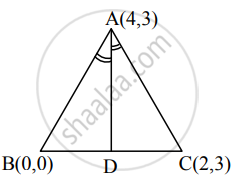Advertisements
Advertisements
Question
If A(4, 3), B(0, 0), and C(2, 3) are the vertices of ∆ABC then find the equation of bisector of angle BAC.
Solution

A(4, 3), B(0, 0) and C(2, 3) are the vertices of ΔABC.
Let AD be the bisector of angle BAC.
Then D divides side BC in the ratio AB : AC.
Now, AB = `sqrt((4 - 0)^2 + (3 - 0)^2)`
= `sqrt(16 + 9)`
= `sqrt(25)`
= 5
and AC = `sqrt((4 - 2)^2 + (3 - 3)^2`
= `sqrt(4 + 0)`
= `sqrt(4)`
= 2
∴ D divides BC internally in the ratio 5 : 2, where B(0, 0) and C(2, 3).
∴ by section formula,
D ≡ `((5 xx 2 + 2 xx 0)/(5 + 2), (5 xx 3 + 2 xx 0)/(5 + 2)) = (10/7, 15/7)`
∴ equation of the angle bisector AD is
`(y - 3)/(x - 4) = (15/7 - 3)/(10/7 - 4)`
∴ `(y - 3)/(x - 4) = (15 - 21)/(10 - 28) = (-6)/(-18) = 1/3`
∴ 3y – 9 = x – 4
∴ x – 3y + 5 = 0.
APPEARS IN
RELATED QUESTIONS
Find the slope, X-intercept, Y-intercept of the following line:
2x + 3y – 6 = 0
Find the slope, X-intercept, Y-intercept of the following line:
x + 2y = 0
Write the following equation in ax + by + c = 0 form.
y = 4
Write the following equation in ax + by + c = 0 form.
`x/2 + y/4` = 1
Write the following equation in ax + by + c = 0 form.
`x/3 - y/2` = 0
Show that lines x – 2y – 7 = 0 and 2x − 4y + 15 = 0 are parallel to each other
Show that lines x − 2y − 7 = 0 and 2x + y + 1 = 0 are perpendicular to each other. Find their point of intersection
If the line 3x + 4y = p makes a triangle of area 24 square unit with the co-ordinate axes then find the value of p.
Find the co-ordinates of the circumcenter of the triangle whose vertices are A(–2, 3), B(6, –1), C(4, 3).
Show that lines 3x − 4y + 5 = 0, 7x − 8y + 5 = 0, and 4x + 5y − 45 = 0 are concurrent. Find their point of concurrence
Find the distance of the origin from the line 7x + 24y – 50 = 0
D(−1, 8), E(4, −2), F(−5, −3) are midpoints of sides BC, CA and AB of ∆ABC Find co-ordinates of the circumcenter of ΔABC
O(0, 0), A(6, 0) and B(0, 8) are vertices of a triangle. Find the co-ordinates of the incenter of ∆OAB
Select the correct option from the given alternatives:
If A(1, −2), B(−2, 3) and C(2, −5) are the vertices of ∆ABC, then the equation of the median BE is
Select the correct option from the given alternatives:
The equation of a line, having inclination 120° with positive direction of X−axis, which is at a distance of 3 units from the origin is
Answer the following question:
Obtain the equation of the line which is parallel to the X−axis and 3 unit below it.
Answer the following question:
Obtain the equation of the line which is parallel to the Y−axis and 2 units to the left of it.
Answer the following question:
Obtain the equation of the line which is parallel to the X−axis and making an intercept of 5 on the Y−axis.
Answer the following question:
Obtain the equation of the line which is parallel to the Y−axis and making an intercept of 3 on the X−axis.
Answer the following question:
Find the distance of the origin from the line 12x + 5y + 78 = 0
Answer the following question:
Find the distance between the parallel lines 3x + 4y + 3 = 0 and 3x + 4y + 15 = 0
Answer the following question:
Find the distance of P(−1, 1) from the line 12(x + 6) = 5(y − 2)
Answer the following question:
Find points on the X-axis whose distance from the line `x/3 + y/4` = 1 is 4 unit
A particle is moving in a straight line according to as S = 24t + 3t2 - t3, then the time it will come to rest is ______
For the lines 5x + 2y = 8 and 5x - 2y = 7, which of the following statement is true?
The equation 3x2 - 4xy + y2 = 0 represent a pair of straight lines whose slopes differ by ______.
If a plane has x-intercept l, y-intercept m and z-intercept n, and perpendicular distance of plane from the origin is k, then _______.
The length of the perpendicular from the origin on the line `(xsinalpha)/"b" - (ycosalpha)/"a" - 1 = 0` is ______.
Find the distance of the origin from the line 7x + 24y – 50 = 0 is:
